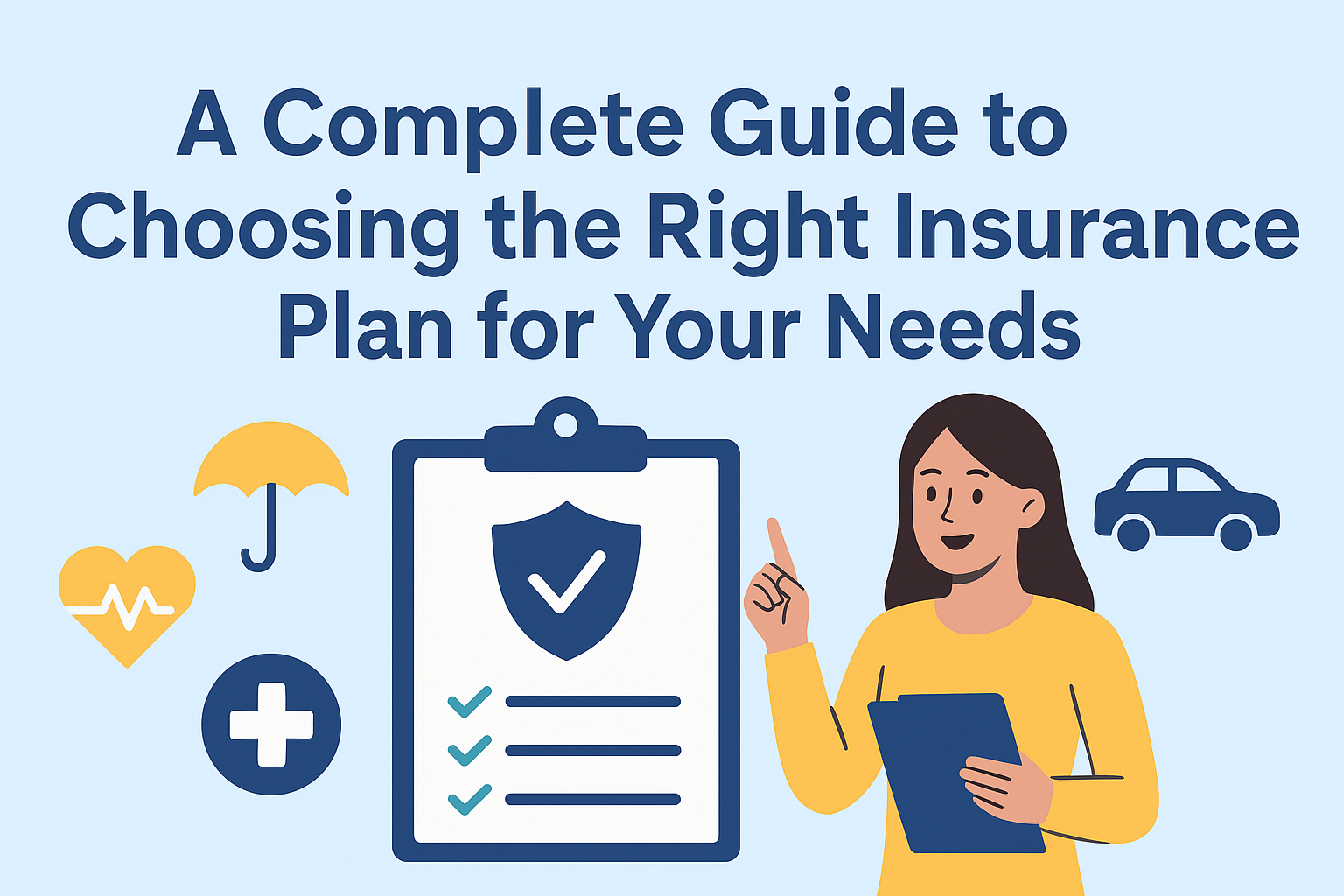
A Complete Guide to Choosing the Right Insurance Plan for Your Needs
Insurance is one of the most important financial tools that provides protection against life’s uncertainties. From medical emergencies and accidents to natural disasters or loss of income, the right insurance plan ensures financial security and peace of mind. However, with so many different types of insurance policies available, choosing the right one for your needs can feel overwhelming.
This complete guide will help you understand the different types of insurance, the key factors to consider, and practical steps to select a plan that aligns with your lifestyle, budget, and long-term goals.
Why Choosing the Right Insurance Plan Matters
Having insurance is important, but having the right insurance plan is even more crucial. A poorly chosen policy may either leave you underinsured—exposing you to risks—or overinsured, where you end up paying unnecessary premiums.
By selecting the right plan:
- You ensure financial protection when you need it most.
- You avoid paying for coverage that doesn’t suit your needs.
- You create a long-term strategy for wealth protection and financial stability.
Step 1: Understand the Different Types of Insurance
Before you choose a policy, it’s important to know the most common types of insurance and their purposes.
1. Health Insurance
Covers medical expenses such as hospitalization, surgeries, doctor visits, and medicines. Some plans also include preventive care and maternity benefits.
2. Life Insurance
Provides financial support to your family in case of your death. It can also serve as an investment tool through policies like whole life or endowment plans.
3. Auto Insurance
Protects against damages to your vehicle and liabilities if you are involved in an accident. In many countries, it is a legal requirement for vehicle owners.
4. Home Insurance
Covers damages to your home and belongings caused by fire, theft, or natural disasters. It helps protect one of your biggest financial assets.
5. Business Insurance
Offers protection for businesses against risks such as property damage, employee issues, and liability claims.
6. Travel Insurance
Covers risks when traveling, such as medical emergencies, trip cancellations, or lost luggage.
7. Disability or Income Protection Insurance
Provides income replacement if you are unable to work due to illness or injury.
Step 2: Assess Your Needs
The best insurance plan for you depends on your personal situation. Here’s what to evaluate:
- Age and Health Condition: Younger people may benefit from affordable premiums, while older individuals may need more comprehensive coverage.
- Family Situation: Married individuals or parents may prioritize life and health insurance for family protection.
- Income and Expenses: Your insurance premiums should fit comfortably within your budget.
- Assets Owned: Homeowners or car owners must prioritize property and auto insurance.
- Job and Lifestyle: High-risk professions or frequent travelers may require specialized coverage.
Step 3: Compare Coverage and Benefits
Not all insurance policies are created equal. When comparing plans, look beyond the price and examine:
- Coverage Limits: How much will the insurer pay in case of a claim?
- Inclusions and Exclusions: Understand what is covered and what is not.
- Premiums: Ensure premiums are affordable long-term.
- Deductibles: This is the out-of-pocket amount you must pay before insurance kicks in.
- Riders or Add-ons: Options like critical illness coverage or accidental disability riders can enhance your protection.
Step 4: Research the Insurance Provider
The insurance company you choose matters as much as the policy itself. Consider:
- Reputation and Financial Strength: Choose a company with strong financial stability.
- Claim Settlement Ratio: This shows the percentage of claims settled successfully. Higher ratios indicate reliability.
- Customer Service: Prompt and supportive service makes the claims process easier.
- Reviews and Recommendations: Check online reviews and ask friends or family about their experiences.
Step 5: Balance Cost and Coverage
It’s tempting to go for the cheapest plan, but lower premiums often mean reduced coverage or higher deductibles. On the other hand, expensive plans may include benefits you don’t need. The right approach is to balance affordability with adequate protection.
Tip: Instead of focusing only on premiums, calculate the total value you’re getting, including benefits, riders, and claim support.
Step 6: Check Policy Flexibility
Life circumstances change—marriage, children, job changes, or buying a home may alter your insurance needs. Choose plans that allow flexibility such as:
- Adding dependents
- Increasing coverage
- Switching benefits
- Upgrading plans
A flexible plan ensures long-term suitability without the need for frequent policy changes.
Step 7: Consult a Financial Advisor (If Needed)
If you find the process overwhelming, consider consulting a licensed insurance advisor or financial planner. They can:
- Analyze your financial goals and risks
- Recommend the most suitable plans
- Help you understand fine print and exclusions
While advisors may earn commissions, their expertise can save you from costly mistakes.
Common Mistakes to Avoid When Choosing Insurance
To make the best decision, avoid these common pitfalls:
- Ignoring Exclusions: Many people focus only on benefits and overlook what’s excluded. Always read the fine print.
- Underinsuring to Save Money: A cheaper premium might leave you with inadequate coverage during emergencies.
- Overlapping Policies: Buying multiple policies with similar benefits leads to wasted money.
- Not Reviewing Periodically: Your insurance needs change with life stages. Review your coverage at least once every two years.
- Choosing Based Only on Price: Cheap policies may come with hidden restrictions or poor claim support.
Practical Example: How to Choose the Right Health Insurance
Imagine you’re a 35-year-old married person with two children. Here’s how you would approach health insurance:
- Assess Needs: Family coverage is essential, with hospitalization and maternity benefits.
- Budget: Set aside a reasonable portion of income (say, 5–7%) for premiums.
- Compare Plans: Look for policies with comprehensive coverage, affordable premiums, and a wide hospital network.
- Check Provider: Select an insurer with a high claim settlement ratio and good customer service.
- Add Riders: Add critical illness or accident coverage for extra security.
By following these steps, you can find a plan tailored to your family’s needs without overspending.
Final Thoughts
Choosing the right insurance plan is not just about protecting your money—it’s about protecting your future and the people you love. With countless options in the market, the process may feel confusing, but breaking it down into steps makes it manageable.
- Start by understanding the different types of insurance.
- Assess your unique needs and lifestyle.
- Compare coverage, cost, and providers.
- Avoid common mistakes and review your policies regularly.
When done correctly, insurance becomes more than just a safety net—it becomes a foundation for financial stability and peace of mind. Remember, the right insurance plan is not the most expensive or the cheapest; it’s the one that gives you the best protection for your needs and goals.
